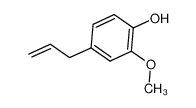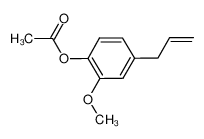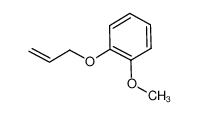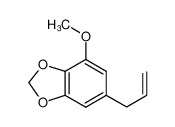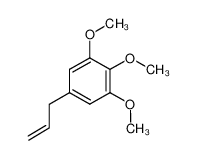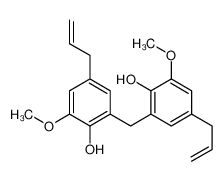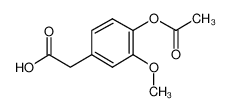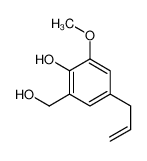| Product name | Engenol |
|---|
| Product number | - |
|---|---|
| Other names | 4-allyl-2-methoxyphenol |
| Identified uses | For industry use only. Food additives -> Flavoring Agents |
|---|---|
| Uses advised against | no data available |
| Company | MOLBASE (Shanghai) Biotechnology Co., Ltd. |
|---|---|
| Address | Floor 4 & 5, Building 12, No. 1001 North Qinzhou Road, Xuhui District, Shanghai, China |
| Telephone | +86(21)64956998 |
| Fax | +86(21)54365166 |
| Emergency phone number | +86-400-6021-666 |
|---|---|
| Service hours | Monday to Friday, 9am-5pm (Standard time zone: UTC/GMT +8 hours). |
Skin sensitization, Category 1B
Eye irritation, Category 2
2.2 GHS label elements, including precautionary statements| Pictogram(s) |  |
|---|---|
| Signal word | Warning |
| Hazard statement(s) | H317 May cause an allergic skin reaction H319 Causes serious eye irritation |
| Precautionary statement(s) | |
| Prevention | P261 Avoid breathing dust/fume/gas/mist/vapours/spray. P272 Contaminated work clothing should not be allowed out of the workplace. P280 Wear protective gloves/protective clothing/eye protection/face protection. P264 Wash ... thoroughly after handling. |
| Response | P302+P352 IF ON SKIN: Wash with plenty of water/... P333+P313 If skin irritation or rash occurs: Get medical advice/attention. P321 Specific treatment (see ... on this label). P362+P364 Take off contaminated clothing and wash it before reuse. P305+P351+P338 IF IN EYES: Rinse cautiously with water for several minutes. Remove contact lenses, if present and easy to do. Continue rinsing. P337+P313 If eye irritation persists: Get medical advice/attention. |
| Storage | none |
| Disposal | P501 Dispose of contents/container to ... |
none
3.Composition/information on ingredients 3.1 Substances| Chemical name | Common names and synonyms | CAS number | EC number | Concentration |
|---|---|---|---|---|
| Engenol | Engenol | 97-53-0 | none | 100% |
Consult a physician. Show this safety data sheet to the doctor in attendance.
If inhaledIf breathed in, move person into fresh air. If not breathing, give artificial respiration. Consult a physician.
In case of skin contactWash off with soap and plenty of water. Consult a physician.
In case of eye contactRinse thoroughly with plenty of water for at least 15 minutes and consult a physician.
If swallowedNever give anything by mouth to an unconscious person. Rinse mouth with water. Consult a physician.
4.2 Most important symptoms/effects, acute and delayedSYMPTOMS: This compound is a primary irritant and sensitizer and can cause contact dermatitis. Irritation of the skin, eyes and respiratory tract occurs. Ingestion of this compound may cause gastroenteritis, vomiting and gastric secretion of mucin. It may also cause abdominal burning, nausea, diarrhea and convulsions. Ingestion of large amounts can cause liver damage and gastrointestinal damage. Inhalation of this compound can lead to bronchial irritation, dizziness, and rapid and shallow breathing. Skin contact may cause an inflammatory reaction on the skin. Prolonged or repeated skin contact may cause allergic dermatitis. Eye contact may cause burns. Skin sensitization may also occur. Symptoms of exposure to this type of compound include intense irritation of all tissues, circulatory collapse, dysuria, hematuria, unconsciousness, tachycardia, pulmonary edema, bronchial pneumonia, abortion and irreversible renal damage. ACUTE/CHRONIC HAZARDS: This compound may be harmful by ingestion or inhalation. It is a primary irritant and sensitizer. When heated to decomposition it emits acrid smoke, irritating fumes and toxic fumes of carbon monoxide and carbon dioxide.
4.3 Indication of immediate medical attention and special treatment needed, if necessaryTreatment is primarily supportive as there is no antidote. If mucosal burns are present, consider endoscopy to look for other ulcerations.
5.Fire-fighting measures 5.1 Extinguishing media Suitable extinguishing mediaFires involving this material can be controlled with a dry chemical, carbon dioxide or Halon extinguisher. A water spray may also be used.
5.2 Specific hazards arising from the chemicalThis chemical is combustible.
5.3 Special protective actions for fire-fightersWear self-contained breathing apparatus for firefighting if necessary.
6.Accidental release measures 6.1 Personal precautions, protective equipment and emergency proceduresUse personal protective equipment. Avoid dust formation. Avoid breathing vapours, mist or gas. Ensure adequate ventilation. Evacuate personnel to safe areas. Avoid breathing dust. For personal protection see section 8.
6.2 Environmental precautionsPrevent further leakage or spillage if safe to do so. Do not let product enter drains. Discharge into the environment must be avoided.
6.3 Methods and materials for containment and cleaning upPick up and arrange disposal. Sweep up and shovel. Keep in suitable, closed containers for disposal.
7.Handling and storage 7.1 Precautions for safe handlingAvoid contact with skin and eyes. Avoid formation of dust and aerosols. Avoid exposure - obtain special instructions before use.Provide appropriate exhaust ventilation at places where dust is formed. For precautions see section 2.2.
7.2 Conditions for safe storage, including any incompatibilitiesStore in cool place. Keep container tightly closed in a dry and well-ventilated place.
8.Exposure controls/personal protection 8.1 Control parameters Occupational Exposure limit valuesno data available
Biological limit valuesno data available
8.2 Appropriate engineering controlsHandle in accordance with good industrial hygiene and safety practice. Wash hands before breaks and at the end of workday.
8.3 Individual protection measures, such as personal protective equipment (PPE) Eye/face protectionSafety glasses with side-shields conforming to EN166. Use equipment for eye protection tested and approved under appropriate government standards such as NIOSH (US) or EN 166(EU).
Skin protectionWear impervious clothing. The type of protective equipment must be selected according to the concentration and amount of the dangerous substance at the specific workplace. Handle with gloves. Gloves must be inspected prior to use. Use proper glove removal technique(without touching glove's outer surface) to avoid skin contact with this product. Dispose of contaminated gloves after use in accordance with applicable laws and good laboratory practices. Wash and dry hands. The selected protective gloves have to satisfy the specifications of EU Directive 89/686/EEC and the standard EN 374 derived from it.
Respiratory protectionWear dust mask when handling large quantities.
Thermal hazardsno data available
9.Physical and chemical properties| Physical state | colourless to faintly yellow liquid with a strong odour of cloves |
|---|---|
| Colour | Colorless or pale yellow liquid |
| Odour | Odor of cloves |
| Melting point/ freezing point | 230°C(lit.) |
| Boiling point or initial boiling point and boiling range | 172°C(lit.) |
| Flammability | no data available |
| Lower and upper explosion limit / flammability limit | no data available |
| Flash point | 127°C(lit.) |
| Auto-ignition temperature | no data available |
| Decomposition temperature | no data available |
| pH | no data available |
| Kinematic viscosity | 7.817 centipoise at 20°C |
| Solubility | In water:slightly soluble |
| Partition coefficient n-octanol/water (log value) | log Kow = 2.49 |
| Vapour pressure | 0.01 mm Hg at 20°C ; 0.03 mm Hg at 25°C |
| Density and/or relative density | 1.066 |
| Relative vapour density | greater than 1.0 (Relative to Air) |
| Particle characteristics | no data available |
no data available
10.2 Chemical stabilityDarkens and thickens on exposure to air.
10.3 Possibility of hazardous reactionsEUGENOL is incompatible with strong oxidizers. This includes ferric chloride and potassium permanganate. It reacts with strong alkalis. It is incompatible with iron and zinc.
10.4 Conditions to avoidno data available
10.5 Incompatible materials/Incompatible with/ ferric chloride, potassium permanganate.
10.6 Hazardous decomposition productsWhen heated to decomposition it emits acrid smoke and irritating fumes.
11.Toxicological information Acute toxicity- Oral: LD50 Guinea pig oral 2130 mg/kg
- Inhalation: no data available
- Dermal: no data available
no data available
Serious eye damage/irritationno data available
Respiratory or skin sensitizationno data available
Germ cell mutagenicityno data available
CarcinogenicityClassification of carcinogenicity: 1) evidence in humans: No adequate data. 2) evidence in animals: Limited evidence. Overall summary evaluation of carcinogenic risk to humans is Group 3: The agent is not classifiable as to its carcinogenicity to humans. /From table/
Reproductive toxicityno data available
STOT-single exposureno data available
STOT-repeated exposureno data available
Aspiration hazardno data available
12.Ecological information 12.1 Toxicity- Toxicity to fish: LC50 Oncorhynchus mykiss (Rainbow trout, juvenile approximately 2-3 months old) 61.5 mg/L/24 hr; 60.8 mg/L/48, 72, 96 hr; static, 15 +/-1°C, mean hardness 95 mg/L CaCO3, average fish loading density was 0.4 (0.3-0.5) g/L, within a bioassay test volume of 20 L.
- Toxicity to daphnia and other aquatic invertebrates: no data available
- Toxicity to algae: no data available
- Toxicity to microorganisms: no data available
AEROBIC: At a concentration of 100 mg/L, isoeugenol (which is structurally similar to eugenol) was found to be readily biodegradable using a Manometric Respirometry Test (OECD Guideline 301F) in which isoeugenol reached 79% biodegradation after 28 days. The biodegradation started on day 2 and reached 79% at the end of the 10-day window period(1).
12.3 Bioaccumulative potentialAn estimated BCF of 20 was calculated in fish for eugenol(SRC), using a log Kow of 2.49(1) and a regression-derived equation(2). According to a classification scheme(3), this BCF suggests the potential for bioconcentration in aquatic organisms is low(SRC).
12.4 Mobility in soilThe Koc of eugenol is estimated as 340(SRC), using a log Kow of 2.49(1) and a regression-derived equation(2). According to a classification scheme(3), these estimated Koc values suggest that eugenol is expected to have moderate to lowmobility in soil.
12.5 Other adverse effectsno data available
13.Disposal considerations 13.1 Disposal methods ProductThe material can be disposed of by removal to a licensed chemical destruction plant or by controlled incineration with flue gas scrubbing. Do not contaminate water, foodstuffs, feed or seed by storage or disposal. Do not discharge to sewer systems.
Contaminated packagingContainers can be triply rinsed (or equivalent) and offered for recycling or reconditioning. Alternatively, the packaging can be punctured to make it unusable for other purposes and then be disposed of in a sanitary landfill. Controlled incineration with flue gas scrubbing is possible for combustible packaging materials.
14.Transport information 14.1 UN Number| ADR/RID: UN3278 | IMDG: UN3278 | IATA: UN3278 |
| ADR/RID: ORGANOPHOSPHORUS COMPOUND, LIQUID, TOXIC, N.O.S. |
| IMDG: ORGANOPHOSPHORUS COMPOUND, LIQUID, TOXIC, N.O.S. |
| IATA: ORGANOPHOSPHORUS COMPOUND, LIQUID, TOXIC, N.O.S. |
| ADR/RID: 6.1 | IMDG: 6.1 | IATA: 6.1 |
| ADR/RID: II | IMDG: II | IATA: II |
| ADR/RID: no | IMDG: no | IATA: no |
no data available
14.7 Transport in bulk according to Annex II of MARPOL 73/78 and the IBC Codeno data available
15.Regulatory information 15.1 Safety, health and environmental regulations specific for the product in question| Chemical name | Common names and synonyms | CAS number | EC number |
|---|---|---|---|
| Engenol | Engenol | 97-53-0 | none |
| European Inventory of Existing Commercial Chemical Substances (EINECS) | Listed. | ||
| EC Inventory | Listed. | ||
| United States Toxic Substances Control Act (TSCA) Inventory | Listed. | ||
| China Catalog of Hazardous chemicals 2015 | Not Listed. | ||
| New Zealand Inventory of Chemicals (NZIoC) | Listed. | ||
| Philippines Inventory of Chemicals and Chemical Substances (PICCS) | Listed. | ||
| Vietnam National Chemical Inventory | Not Listed. | ||
| Chinese Chemical Inventory of Existing Chemical Substances (China IECSC) | Listed. | ||
| Creation Date | Aug 12, 2017 |
|---|---|
| Revision Date | Aug 12, 2017 |
- CAS: Chemical Abstracts Service
- ADR: European Agreement concerning the International Carriage of Dangerous Goods by Road
- RID: Regulation concerning the International Carriage of Dangerous Goods by Rail
- IMDG: International Maritime Dangerous Goods
- IATA: International Air Transportation Association
- TWA: Time Weighted Average
- STEL: Short term exposure limit
- LC50: Lethal Concentration 50%
- LD50: Lethal Dose 50%
- EC50: Effective Concentration 50%
- IPCS - The International Chemical Safety Cards (ICSC), website: http://www.ilo.org/dyn/icsc/showcard.home
- HSDB - Hazardous Substances Data Bank, website: https://toxnet.nlm.nih.gov/newtoxnet/hsdb.htm
- IARC - International Agency for Research on Cancer, website: http://www.iarc.fr/
- eChemPortal - The Global Portal to Information on Chemical Substances by OECD, website: http://www.echemportal.org/echemportal/index?pageID=0&request_locale=en
- CAMEO Chemicals, website: http://cameochemicals.noaa.gov/search/simple
- ChemIDplus, website: http://chem.sis.nlm.nih.gov/chemidplus/chemidlite.jsp
- ERG - Emergency Response Guidebook by U.S. Department of Transportation, website: http://www.phmsa.dot.gov/hazmat/library/erg
- Germany GESTIS-database on hazard substance, website: http://www.dguv.de/ifa/gestis/gestis-stoffdatenbank/index-2.jsp
- ECHA - European Chemicals Agency, website: https://echa.europa.eu/





